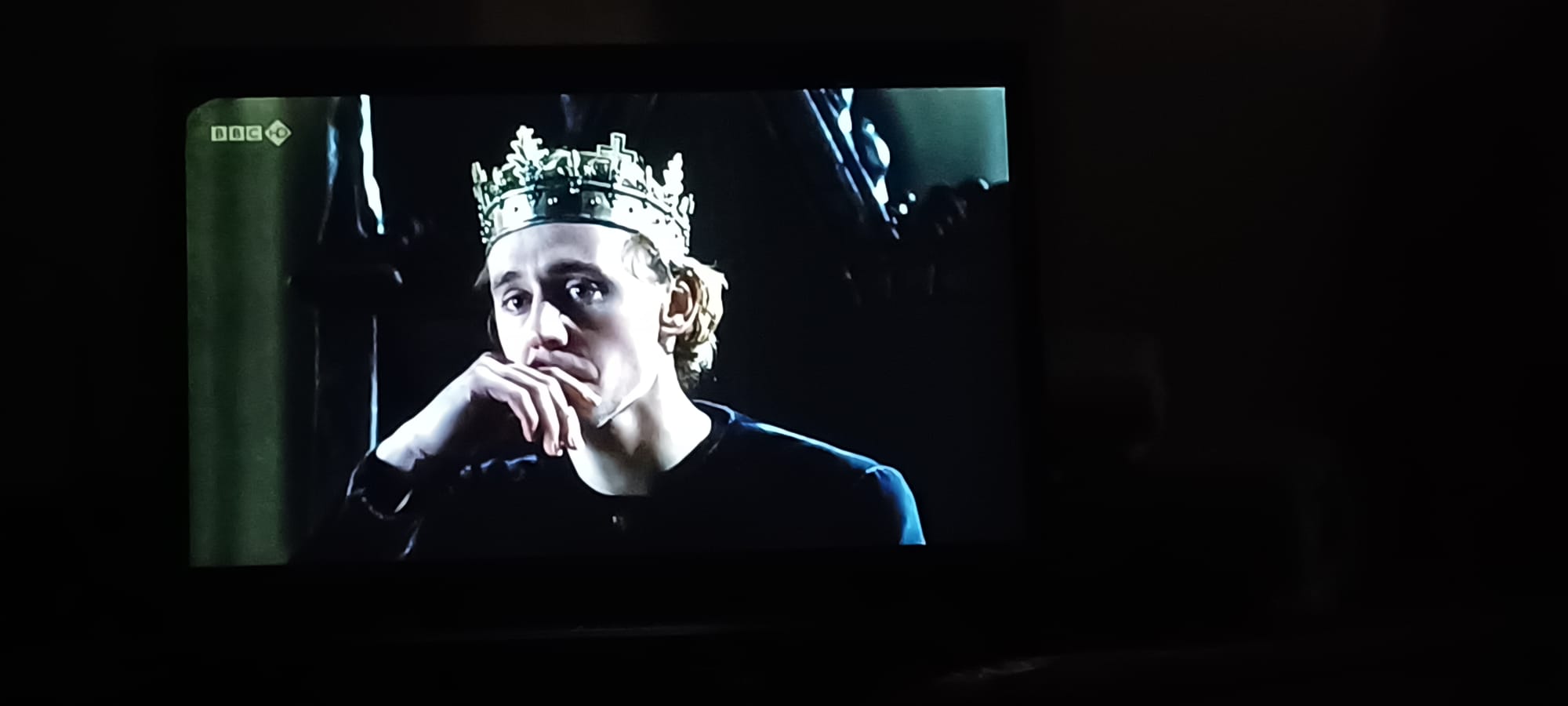
The Two Noble Kinsmen is the last of 39 plays to the Shakespeare oeuvre, written toward the end of his career in 1613 in collaboration with his colleague John Fletcher just three years before he died. It wasn’t included in The First Folio (1623, what a happy year to remember for AP English students across the US. I will be writing more about this anniversary).
Perhaps John and Will struggled to find or agree on a plot. Likely they needed a new piece for the 1613 season. The story’s taken from “The Knight’s Tale,” the first of Chaucer’s Canterbury Tales (c. 1387-1400), which itself was condensed from “Il Teseida” by Boccaccio (written before 1341). Apparently playwrights freely plundered the Chaucer text for new stage material. Elizabethans couldn’t get enough of the quaint, bawdy, moralistic tales from the Before Times. Chivalry! Ceremony! Rivalry! Fortune! Fate! STEP RIGHT UP, IT’S ALL HERE, PEOPLE.
We open with preparations for the wedding of Theseus and Hippolyta, placed on hold for 15 years from the end of the action in A Midsummer Night’s Dream. Placed on hold this time AGAIN by three mourning widows who need to collect their husbands’ bodies from the battlefield. Hippolyta wonders who Theseus loves more, her or his best friend Pirithous. She reviews these annoying fears with her sister Emilia, who brings up her best friend Flavina who died when the girls were eleven. Emilia asserts that for her, a virgin spinsterhood is preferable to marriage
We meet the two kinsmen, as close as two soldier-cousins can be. The stage is thus set, in every way, to confront an old, old question: who loves who more, even after death? Can new loves supersede old loves? Are they placed in different categories as life moves forward – otherwise it could not progress? The three widowed queens bury their dead kings. No word in the play regarding whether or not they wish too to find new love, or if they’ll remain devoted to the memory of their slain husbands. One suspects the latter.
The play today offers great potential for parlor games among English academics, teasing out what aspects of the play to ascribe to Shakespeare versus Fletcher. Critics and literary historians, for their part, believe that all of Scene One was written by Fletcher, agreeing that Shakespeare started to write at Scene Two, Act One. (I have also seen literary criticism that asserts that Shakespeare wrote Act I, Act III Scene 1, and the Act V invocations in Scene 1, so take your pick. Perhaps an English professor friend might take pains to set me right on these points.) At a minimum we can say that this piece was not considered to be fully part of the canon since it didn’t appear in the First Folio or, in fact, in print at all until 1634.
The Jailer’s Daughter exclaims when she sees the prisoners Arcite and Palamon (the two cousins – soldiers – possibly lovers), “It is a holiday to look on them! Lord, the diff’rence of men!” This subplot with the Jailer’s Daughter is a Globe invention – her weird crush on Palamon, her aid in his escape, her descent into lovesick madness and the sex cure all were added by Team Shakespeare-Fletcher. I think of Will suggesting a subplot to mirror the action in the main plot, to lock it, refract it, take it to its human extreme. “This is not gonna work, John. Story needs a subplot to work,” I can hear him saying over pints of ale.
Fletcher takes over again in the Tudor Mad Lib, writing the conflict that arises between Arcite and Palamon when they spy Emilia. He was said to be a master of the plot twist. It is thought that he added Theseus’s insistence on death to the loser of the match between Arcite and Palamon, raising the stakes on Emilia’s angst. The play’s waters grow ever choppier as the styles of the two collaborators refuse to reconcile. Arcite wins the duel, and Theseus accordingly gives him Emilia, leading her to protest her role as pawn in men’s games. She bids Arcite farewell and speakers no further in the play. Is this Shakespeare’s saddest wedding? Even Chaucer made it joyful. Arcite dies, crushed by a horse in a literal deus ex machina. The now-silent Emilia is given in turn to Palamon. Meanwhile, the Jailer’s Daughter has successfully received her sex cure at the hands of the Wooer, disguised as Palamon, and in her raving madness she fails to discern the difference.
A side note: this play features Morris dancing, which I had to look up, again. This was a huge thing in Tudor England (etymology: English moorish, Spanish morisco (which means moor) = moorish) where all-male teams (“sides”) engaged in dance-offs wearing large jingle bells on their shins. (This reminds me a lot of a cultural night I saw once at my old job, where some Bolivian students engaged in a purportedly indigenous Bolivian folk dance with GIANT jingle bells. Memorable.) Morris dancing died off with Cromwell in the mid-1600s but made an Edwardian resurgence in the late 19th century and is now amply supported within English popular culture. Fletcher probably added the Morris dancing to deflect audience detecting of the yawning holes in the plot, roughly at the same place in the play that we see the play-within-a-play in A Midsummer Night’s Dream. I don’t think Will would have added the dancing, personally. Or maybe he did. It’s a local touch of color that we often see in the plays, keeping the groundlings and lords alike amused.
This piece also has been getting new attention recently due to all the same-sex intrigue between Theseus and Pirithous, Emilia and Flavina, and those two extra-noble kinsmen, Arcite and Palamon. It’s hard to say contextually how this was received on the Tudor stage, but this aspect makes the play fresh and relevant for 2023. I found a lovely production of The Two Noble Kinsmen online from the drama department of Loyola Marymount University It is truly indispensable to see the lines spoken to maintain any kind of an understanding of the play. Honestly, I struggle with the text alone. The play’s the thing! The kids did a great job, especially Hippolyta and the Jailer’s Daughter, and I hope those two actors go pro. (The two noblemen themselves were just cousins; Theseus was hetereonormative; Hippolyta seemed very aware of her cousin’s dead love, who died when Emilia was just 11, so really, what kind of love are we taking about here?)
Some outstanding lines:
The world’s a city full of strange streets / Death the marketplace where each one meets
They are famed to be a pair of absolute men!
The lower of the twain ….
Those hopes are prisoners with us
This garden has a world of pleasures in it
I am wondrous, merry-hearted (I think this was the Jailer’s Daughter getting manic)
He’s excellent in the woods; bring him to the plains, and his learning makes no cry
His body and fiery mind illustrate a brave father
Sit down, and good now!
If there be a place for those that sleep in honor
A most thick and profound melancholy (regarding the Jailer’s Daughter and her infatuation with Palamon)
He lives! / But such a vessel / floats but for the next surge. (Emilia, right before Arcite dies. Sorry, lady! Your arranged marriage didn’t last long but we’ll arrange another one for you right away! Meet your new husband – Palamon!)
I’ve been seasoning my primary texts with some forays into commentary. This weekend, thanks to an unplanned and comprehensive internet outage, I read the entirety of William Shakespeare: A Handbook (Parrott, 1934). Not only was it informative but I felt like I was an undergraduate once more with the vintage tome and its green leather cover, straight out of the stacks. It’s so grounding to remember that Shakespeare practically adapted from source material every play he ever wrote (from Dante, Chaucer, Boccaccio, Holinshed, Terence, Plautus, Plutarch’s Lives, and more), slicing and dicing, condensing and expanding, arranging and adding as needed.
(I wrote the first half of this commentary right before we were kicked out of the Digital Age. I always say that no one moves to Italy for the wifi – come for the food, the wine, the weather, the fashion, beautiful people, design, great hair, espresso, spritz, and countless other treats, but do not come to Italy for the wifi. No one does. And if you do move to Italy and get upset about the wifi, well, they should just show you the door.)
Next up, Julius Caesar (adapted from the Plutarch), which I last read in 1989 in Honors English with Mrs. Kelly. Bless her. I’ve never been able to find her again, in spite of numerous earnest searches in different decades since then. I am sure I will think of her when I tackle Caesar once more. I meant to read Caesar for the Ides of March, but life and Italy got in the way, as it were. ‘Twill be no less heartfelt for being less coincident.








